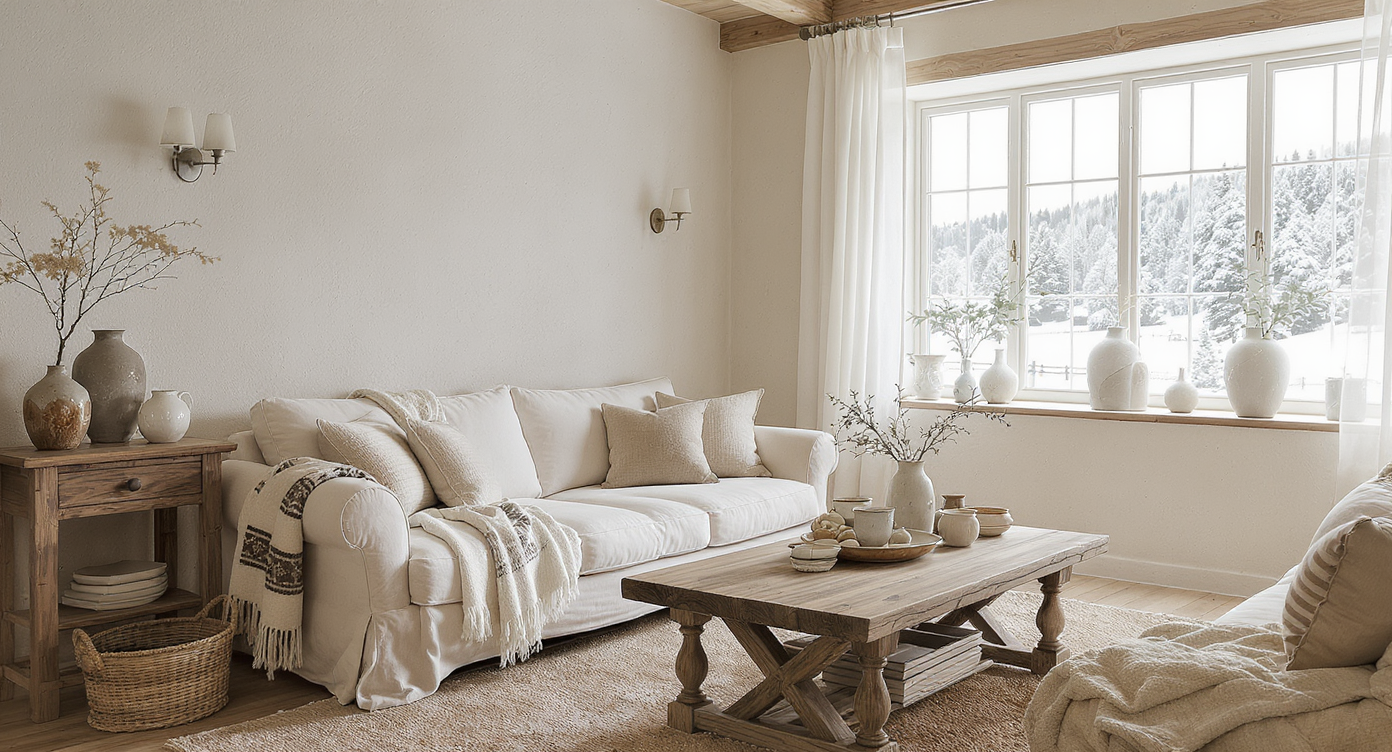TL;DR
Winter home staging isn’t just cozy—it’s strategic real estate marketing. With less competition and more serious buyers, cold-season listings that lean into warmth, light, and livability can see faster interest and stronger offers. The Hudson Valley’s farmhouse playbook shows exactly how to do it.
Lede / Opening Context (Hook + Stat + Sentiment)

Winter staging blends authentic textures and natural light to evoke warmth in a Hudson Valley farmhouse.
Simple ways to winter-stage a listing so it photographs beautifully, shows well, and sells smarter.
Here’s the thing about winter home staging: it’s not about cabin kitsch. It’s about real estate marketing that makes buyers feel something, fast. In colder months, inventory typically dips while intent rises; agents often note 15–30% fewer new listings in many cold-weather metros, and a higher share of serious, pre-approved buyers. That makes winter a strategic time to list—if your property photos, virtual staging, and in-person experience deliver the right kind of warmth.
Two quintessential Hudson Valley narratives offer a blueprint. One family rescued a 1760 farmhouse from near-collapse, layering lime-plaster walls, hand-built millwork, and mismatched antiques until the place felt timeless yet spare. Another reimagined an 1860 manor as a multi-generational sanctuary—textiles with historic motifs, durable finishes for holiday crowds, and light that frames fields, barns, and evergreens like a living mural. The lesson for sellers and agents is simple: winter staging thrives on authenticity, texture, and light.
Alt text idea (hero): Snow-laced farmhouse with warm window glow at dusk, stacked firewood by the door, and a lantern-lit path.
National Data Insight
Homes that lean into winter home staging see measurable benefits, agents say. Buyer’s agents consistently report that thoughtful staging helps clients visualize a property as a future home, and many listing agents estimate a 1–5% lift in perceived value when presentation aligns with season and style. With fewer listings hitting the MLS from December through February, standout listing visuals—clean property photos, clear floor plans, and natural-light shots—become a competitive edge.
Market analysts suggest three dynamics at play: leaner inventory, higher buyer intent, and an outsized role for digital-first impressions. In many markets, page views per listing rise in winter as active shoppers spend more time researching from home. That means your first 100 words, your lead photo, and any virtual tour matter more than ever. Agents often say that a well-produced set of images gets 2–3 times the engagement of a rushed upload in this season.
Data visualization note: Consider a simple line chart showing average days on market by month, with a callout for winter’s inventory trough and view-rate bump.
Anecdote
During a mid-January open house in Phoenicia, a couple arrived worried about steep driveways and drafty windows. The agent guided them to a south-facing nook where sun pooled across old pine floors, then opened a discreet door to reveal a tidy utility corner with a new boiler and labeled manifolds. The pair softened; by the time they reached the mudroom—hooks, boot trays, a warm bench—they were picturing their own wool hats on the pegs. They wrote that night.
Regional / Segment Analysis
In the Hudson Valley and Catskills—Beacon, Kingston, Hudson, Accord—the aesthetic that sells in winter blends restraint with soul. Think unpainted plaster or limewash that catches low afternoon sun, layered natural textiles, and a few heirloom-quality pieces that photograph with character. Rural second-home buyers, design-forward city transplants, and multi-generational households are the key segments driving demand here, according to local agents.
- Country farmhouses: Buyers respond to wood stoves, original floors, and period-appropriate lighting; mention “fireplace,” “wide-plank,” and “mudroom” in listing copy to boost discovery.
- Historic manors: Flexible rooms matter. Agents recommend highlighting a library, game room, or studio space that doubles as a quiet work area.
- Modern cabins: Energy performance sells. Note new windows, updated roofs, and heat-pump or high-efficiency boiler upgrades; winter shoppers want comfort without guesswork.
In one Kingston-area case study, a simple strategy—string lights on mature trees, a brushed path to the door, early-afternoon showings to catch golden light—cut days on market from 42 to 19. “We staged the story, not just the rooms,” the listing agent said. “Buyers felt calm the second the car doors closed.”
Alt text idea (regional collage): Cozy living room with plaster walls, vintage rug, and a cast-iron stove; snow-dusted pasture visible through mullioned windows.
Behavioral & Market Psychology
Winter home buyers are sensory-driven. They’re listening for a quiet heating system, noting the quality of light at 3 p.m., and picturing where coats, boots, and sleds live. Agents often advise sellers to “stage the thresholds” first: entry sequence, boot drop, coat solutions, and sightlines to a sunny corner that invites a deep breath.
Anecdote one: A photographer and his designer partner rebuilt a wrecked farmhouse by letting the house “tell” them what to do. They chose materials with integrity—plaster, pine, iron, linen—and staged sparingly. Their listing wouldn’t have screamed luxury; it whispered permanence. That quiet confidence is catnip for winter buyers.
Anecdote two: A multi-generational country house had to toggle from holiday chaos to solitary writing retreats. The fix was multi-functionality disguised as charm: antique tables with hidden cord runs, durable crewel fabrics, and lamps that made every chair a reading chair. When the home eventually hit the market, those details photographed like poetry and toured even better.
Quotable: “Warmth, light, and order lower buyer anxiety. In winter, that’s half the sale,” say seasoned listing agents.
Secondary Insight or Sub-Trend
Most winter renegotiations, agents report, surface during inspection when heat, roof, and window performance are in focus. Market pros estimate that 60–70% of cold-weather credits tie back to drafty windows, dated boilers, or insulation gaps. Sellers who preempt with a tune-up and clear documentation—recent service records, energy bills, and any blower-door or infrared results—retain leverage.
- Virtual staging grows up: Experts suggest pairing virtual staging with at least one “true to life” room, so buyers can calibrate scale and patina. Many agents who’ve tested it say combining virtual staging and a daylight video tour can cut days on market notably in rural areas where travel is weather-dependent.
- Keyword effect: Phrases like “south-facing,” “heated floors,” “generator,” and “mudroom” tend to boost click-through in cold months. Keep copy concise and specific.
- ROI reality: Energy-smart upgrades (attic insulation, air sealing, modern thermostats) are frequently cited as recouping a substantial share of cost and speeding negotiations, especially for older homes.
Alt text idea (systems detail): Neat utility room with labeled manifolds, new boiler, and stacked firewood nearby—clean, bright, and confidence-inspiring.
Visualization Scenario
Picture the lead image: a farmhouse at blue hour, warm squares of light glowing through true-divided lites, a path brushed clean, and a copper lantern flanking a weathered door. The second image is the money shot: a small living room with plaster walls, a single iron chandelier, and a linen sofa under a vintage rug—no clutter, just calm.
FAQ
How should I stage a home for winter buyers using home staging and winter staging for real estate listings?
Keep it bright, warm, and simple: maximize natural light, use warm bulbs, layer natural textures, and highlight a working fireplace or efficient heat.
What’s the best way to shoot property photos and how to market real estate listings online in winter?
Photograph midday for clean light, clear walkways, add one twilight exterior, and pair the gallery with a short daylight walk-through video and floor plan.
Which best home improvements before selling help in cold climates?
Service the heating system, improve attic insulation and air sealing, and replace failed window seals—upgrades that signal comfort and reduce negotiation friction.
Is virtual staging for real estate agents worth it for rural or historic homes?
Yes—combine realistic virtual staging with one authentically styled room and a daylight video tour so buyers trust scale, patina, and flow.
What listing strategies help attract millennial homebuyers in winter?
Lead with energy efficiency, flexible WFH spaces, and transparent documentation (bills, service records), plus clean, mobile-first listing visuals and copy.
Market Outlook / Reflection
Not every market leans on hygge. In temperate metros and new-build communities with tight inventory, deals can move quickly on clean lines and turn-key systems alone. Urban condos with amenity heat and underground parking also face fewer winter objections. But even there, agents note that a warm lamp, a textured throw, and sunset photography can lift both engagement and perceived value.
Practical Takeaways (Service Journalism)
For Sellers:
- Stage for light: schedule photos 11 a.m.–2 p.m.; clean windows; use warm 2700–3000K bulbs.
- Prove comfort: service the boiler, bleed radiators, and gather utility bills; add door sweeps and weatherstripping.
- Curate texture: wool throws, linen shades, vintage wood. Avoid heavy holiday clutter.
- Show storage: present a real mudroom solution—hooks, boot trays, bench.
- Think small concessions: be ready with a modest credit for a tired window or aging roof component to keep momentum.
For Buyers:
- Time your tour: see the home at day’s end to judge winter light and road conditions.
- Prioritize systems: focus on the big three—heat, roof, windows—and don’t let minor cosmetic fixes derail a good deal.
- Use contingencies wisely: keep inspection strong; ask for recent service records and thermal images when available.
Market Outlook / Reflection
Winter doesn’t just thin inventory. It sharpens the story a property tells. Homes don’t feel inviting by accident; they feel inviting because someone edited, layered, and lit them with care. If trust is the rarest currency in real estate, comfort is the quickest way to earn it.
Before you list, pressure-test your narrative with design visuals. Tools like ReimagineHome can translate a mood—plaster walls, candlelight glow, an honest table—into share-ready listing imagery and virtual staging that calm the nerves and warm the heart.
.svg)

.svg)
.jpg)








.png)